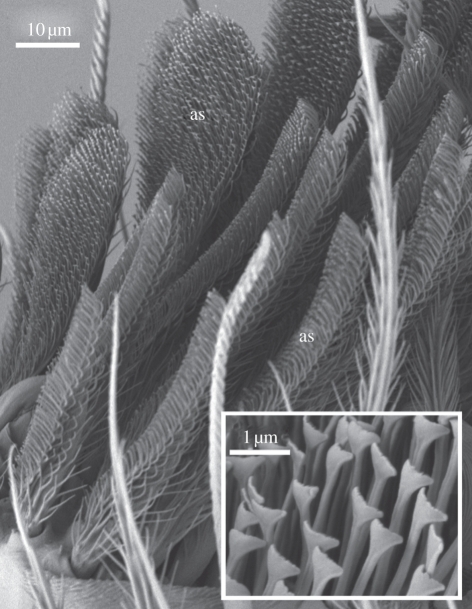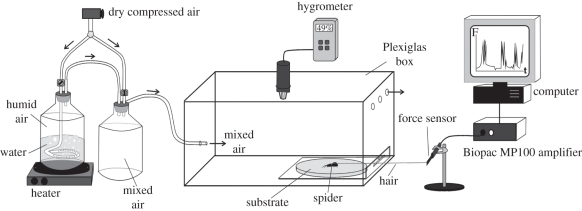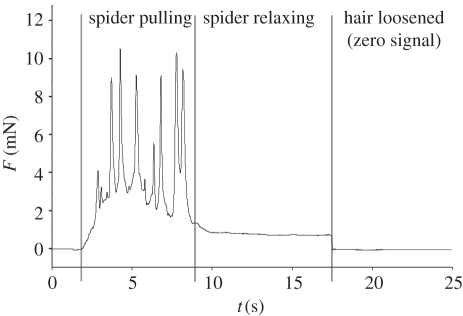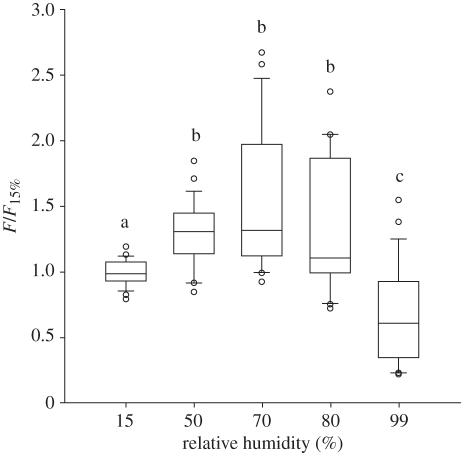Abstract
Hairy attachment devices that are not supplemented with fluid secretion have evolved independently in lizards and spiders. van der Waals forces have previously been shown to be responsible for excellent adhesive properties of these structures, but it has recently been reported that wetting phenomena also play an important role in such ‘dry adhesives’. To investigate the effect of ambient humidity on the attachment of the living spider Philodromus dispar, traction force was measured on a smooth epoxy resin surface at relative humidities (RHs) of 15, 50, 70, 80 and 99 per cent. The results show that attachment ability is significantly higher at an intermediate humidity compared with that in a dry atmosphere and at high humidity. Water condensation on the substrate surface almost completely abolishes adhesion. Experimental results obtained may be explained by an increase in capillarity or changes in mechanical properties of setae and spatulae owing to water absorption by the cuticle at an intermediate RH. The results obtained show dry adhesion limits under different environmental conditions and are important for understanding spider biology.
Keywords: attachment, adhesion, friction, cuticle, microstructure, Arthropoda
1. Introduction
Hairy attachment pads based on the dry adhesion mechanism have evolved independently in such distant groups as spiders and lizards [1–3]. They are a fascinating example of devices that produce a strong adhesion force merely through morphological features: elaborate micro- and nanostructures with flattened terminal elements (spatulae) [4–7]. It is generally accepted that adhesion in such systems is because of short-range molecular van der Waals forces. Such a very close contact is achieved by dividing large contact into fine subcontacts and by flexible tape-like tips [8–10].
The contribution of van der Waals forces to adhesion mechanisms is widely accepted for geckos, but it has not, as yet, been rigorously proven for spiders. Homann, who first studied the functional mechanism of the attachment system in wandering spiders, suggested that adhesion is achieved by cohesive forces of a thin water film that usually occurs on most natural surfaces [6,11,12]. In modern nanotechnology, it is well known that a thin, humidity-dependent water layer on solids has an influence on adhesion [13–15]. Huber and co-workers [16] reported that such wetting phenomena enhance the adhesive ability of gecko setae. Niewiarowski and co-workers [17] reported a significant effect of temperature and humidity on the attachment ability of living geckos. Other authors reported that humidity enhances the adhesion of the ‘dry’ cribellar threads of spiders [18]. Recently, Puthoff and co-workers [19] reported on an effect of humidity on the mechanical properties of gecko seta material, which might represent another mechanism of adhesion enhancement with an increase in environmental humidity. Keeping this in mind, one may hypothesize that animal adhesion at different environmental humidities may strongly differ. Since even the same animal species operates in various environments, understanding the role of humidity in attachment ability is an important issue for the biology of animals with dry adhesive systems.
In the present work, the effect of humidity on the adhesion of hairy attachment devices was studied in the running spider, Philodromus dispar. In this species, the hairy adhesive pads (so-called scopulae) are similar to the adhesive pads of geckos owing to hierarchically branching setae, terminal tape-like ends (spatulae) and the lack of a fluid secretion. Both systems contain proteins in their material composition [20–22]. The attachment of living spiders was investigated under different relative humidities (RHs) ranging from 15 to 99 per cent, to reveal the influence of environment on the attachment ability of spiders under semi-natural conditions.
2. Material and methods
(a). Animals
Philodromus dispar Walckenaer 1826 (Araneae, Philodomidae) is a philodromid spider widespread in Europe. Representatives of the family Philodromidae are diurnal, mainly ambushing hunters that are by nature fast runners. These spiders have a highly specialized claw scopula (figure 1). Philodromus dispar individuals were collected in the New Botanic Garden of Kiel University in May and June 2010. They were usually found sitting on big-leaved herbal plants in semi-shady areas.
Figure 1.
Lateral view at the adhesive setae (as) of Philodromus dispar pretarsus. Inset shows spatulae of an adhesive seta.
Collected individuals were anaesthetized with carbon dioxide and their spinnerets were sealed with a minute droplet of melted wax to prevent spinning silk that might potentially contaminate the scopulae and substrate. The animals were then weighed on an AG 204 Delta Range scale (Mettler Toledo GmbH, Greifensee, Switzerland). Females were more than two times heavier than males (females: 25.3 ± 7.7 mg, n = 10; males: 11.0 ± 0.8 mg, n = 5; mean ± s.e.m.). The spiders were kept in plastic tubes at a temperature of 22–24°C and an RH of 40 to 50 per cent, and were fed with juvenile house crickets (Acheta domesticus) obtained from a local pet shop.
(b). Traction force measurements
A set-up was constructed for this experiment in which the humidity could be controlled and changed by mixing dry and wet air within a Plexiglas chamber of 30 × 14 × 14 cm (figure 2). A smooth epoxy resin plate, cast from a glass surface using a two-step moulding method was used as substrate [23]. Prior to the experiment, spiders were first anaesthetized with carbon dioxide and then one end of a 15–20 cm long human hair was fixed with a droplet of molten wax on the prosoma. The other end of the hair was fixed to a force sensor that was connected to a FORT-10 transducer (10 g capacity; World Precision Instruments, Inc., FL, USA). Force–time data were recorded using AcqKnowledge v. 3.7.0 software (Biopac Systems Ltd, Goleta, CA, USA).
Figure 2.
Experimental set-up for traction force experiments in a controllable humid environment. The spider is connected to the force sensor by a 15–20 cm long human hair. Time–force curves are recorded with AcqKnowledge v. 3.7.0 software. Humidity is controlled by mixing dry compressed air (approx. 15% relative humidity) and wet air. To achieve a high humidity, a heater was used in order to increase the amount of water vapour. Temperature was continuously monitored in the chamber to ensure that the use of the heater did not lead to temperature increase within the chamber.
The tethered spider was left in the chamber. After 5 min of acclimatization, the animal was animated, with a slight push, to run in a direction perpendicular to the force sensor. When the spiders pulled on the hair, time–force curves were recorded. The generated traction force should depend on both the strength of the animal and attachment to the substrate. As the spiders did not pull continuously, only the three highest peaks of the time–force curves during 10 s of the experiment were taken into account (figure 3). The animals were very quickly exhausted, after just a few pulls, and then tended to rest at a residual force of 0.6 mN. If the spider did not pull in the right direction after a few trials, it was loosened and put back into the plastic tube to recover. Eight female specimens were tested in this experiment. The humidity was changed in a randomized order and each time the animals were given 5 min to adapt to the new environmental conditions. The experiment was carried out in daytime at 24°C.
Figure 3.
Time–force curve obtained from a single run at a relative humidity of 70 per cent. Peaks indicate the maximal traction force generated by the spider in the course of 10 s. Only the three highest peaks were taken into account.
Force data were tested with Kruskal–Wallis one-way ANOVA on ranks using SigmaStat software (Systat Software Inc, San José, CA, USA).
3. Results
The traction forces achieved at the same RH strongly varied among individuals. As the maximum force did not correlate with body mass, data were normalized to the average maximum force obtained for each individual at 15 per cent RH.
Spiders achieved the highest traction forces in an environment of 70 per cent RH (figure 4). The forces here were about 50 per cent higher than those measured at 15 per cent RH. The forces measured at 50 and at 80 per cent RH also differed significantly from those at 15 and at 99 per cent. There was no significant difference between 50, 70 and 80 per cent RH (although they tended to be lower at 50 and 80%). Very low forces were detected at 99 per cent humidity. Under these conditions, water condensation was occasionally observed on the substrates within the testing chamber. If condensed water was visible on the substrate, the substrate became slippery for the spider's scopula.
Figure 4.
Maximum traction force achieved by spiders of Philodromus dispar under various humidities. Data are normalized to the average value of traction force maxima obtained for individual animals at 15 per cent relative humidity. Box endings describe the 25th and 75th percentiles; the line within shows the median; whiskers define the 10th and 90th percentiles; remaining values are marked by single circles. Significant differences are marked by different letters (Tukey test with p < 0.05).
4. Discussion
(a). Humidity optimum for dry adhesion
The importance of an absorbed water layer for adhesion of a spider scopula was first proposed by Homann [6], who observed that spiders failed to attach to a strongly hydrophobic silanized glass plate. It was reported that the gecko cannot adhere to a hydrophobic surface of polytetrafluoroethylene [5]. The problem with both experiments was that these materials were weakly polarizable, which resulted in a reduction of the action of van der Waals forces. To answer the question of whether capillary or van der Waals forces contribute to gecko adhesion, Autumn and co-workers [2] tested the adhesion force of living geckos and their single setae on hydrophilic silicon dioxide (SiO2) and hydrophobic-polarizable gallium arsenide (GaAs) wafers. As they found no difference in adhesion between these substrates, they excluded capillary effects and assumed van der Waals forces to be the main mechanism of gecko adhesion. However, Huber et al. [16] first showed that adhesion of a single spatula on different substrates increases linearly with increasing environmental humidity. Later, an increase in the attachment ability of the gecko together with increasing humidity was demonstrated for living geckos [17]. Our data show, for the first time, similar effects for different dry adhesive systems of spiders. Similar to the experiments on geckos, an increase in the attachment ability of the spider P. dispar with increasing humidity was detected. However, this is only valid for RH ranging from 15 to 70 per cent. A further increase in humidity leads to a reduction in the attachment ability up to almost the complete absence of it at an RH of 99 per cent. The effect of adhesion reduction at higher RHs has not been previously discovered for dry attachment systems, because earlier experiments were performed at RHs ranging from 1.5 to 60 per cent [16] and 15 to 80 per cent [17].
(b). The influence of humidity on the adhesion of small contacts
Capillary forces are supposed to be the major adhesion mechanism in insect attachment devices that produce a fluid secretion at the tip of each tenent seta [24]. In spiders and geckonid lizards, where no secretion occurs, capillary forces may only be generated by the presence of ambient water. They can come into play when there is a layer of water on the surface that is thick enough to build a liquid meniscus. For a smooth contact surface, such a critical thickness is supposed to be 0.7 nm [13,25]. The humidity of the air which is necessary to form such a water layer depends highly on physico-chemical properties of the substrate. On micro-rough surfaces, the amount of water must be high enough to span the asperities, so that a high RH (70–99%) is necessary [26]. On a smooth hydrophilic SiO2 surface, the water film already has liquid properties above 60 per cent RH [13]. Below that, the molecules in the water layer are composed in a solid-like manner. The capillary force should be higher on hydrophilic materials because of the lower contact angle and therefore stronger substrate wettability [25]. Strongly hydrophobic surfaces, such as a silanized SiO2 plate, show adhesion that is nearly independent of humidity [15].
An adsorbed water layer usually occurs on most natural surfaces at an RH above 15 per cent [27]. The van der Waals force between two solid bodies strongly depends on the medium phenomena expressed by the Hamaker constant. As the Hamaker constant is much smaller for water than for air, van der Waals forces should be low at a large water meniscus. Conversely, the contribution of capillarity to adhesion should become stronger. In reality, the properties of water on a nanoscale are more complex. While capillarity in macroscopic systems is said to be independent of RH, a strong dependence on the presence of water vapour has been investigated in nano-contacts [13–15]. The adhesion between a 20 nm broad atomic force microscope (AFM) tip of SiO2 or Si3N4 and a smooth SiO2 surface increases with increasing RH, reaching a maximum between 30 and 60 per cent and then decreasing again [13,15]. This behaviour is very similar to the results obtained in the present study, although the chemistry of materials is different. With the help of attenuated total reflection infrared spectroscopy, Asay & Kim [13] showed that the physics of a film of water on SiO2 radically changes with RH [13]. Below RH of 30 per cent, the film is only a few molecular layers thick (0–8 Å), forming an ice-like structure in which the molecules are connected with four hydrogen bonds (instead of 2.5 in liquid water). This conformation leads to a much higher surface energy at an RH below 60 per cent than it is observed for condensed liquid water at an RH above 60 per cent. That is why, in the RH range 0 to 60 per cent, surface tension forces rise with the growing meniscus, leading to an increased capillary force, but the capillary force falls at high humidity, when the meniscus becomes thick. With the growing meniscus, the van der Waals force decreases continuously, owing to the reduction of the Hamaker constant in water. The resulting adhesion curve averaging contribution of van der Waals force and capillary force shows a maximum between 60 and 90 per cent [15]. In spite of the difference of the materials used by Xiao & Qian [15] from that of biological systems, the results obtained in their AFM study can be excellently applied to the results of the present study and results previously obtained on geckos [16].
(c). Does humidity modify adhesion owing to the change in the material properties of spatulae?
Atmospheric water can potentially be absorbed by the spatulate contact elements. Higher water content leads to the reduction of the elasticity modulus and to an increased flexibility of the cuticle [28]. This results in higher adaptability of spatulae and setae to uneven surface profiles. This argument was recently used as an explanation for humidity-enhanced adhesion of gecko setae [19]. In insects it has been reported that resting in a humid environment positively influences attachment forces [29]. This could be owing to the hydration of setae. In spider legs, desiccation leads to reduced friction forces generated by the metatarsal scopula [30]. This result was explained as a reduction of flexibility of cuticular structures, which could explain why attachment forces were reduced under dry conditions in this study.
(d). Fluid water reduces attachment
The present study shows that attachment forces are strongly reduced at high RH conditions (99%). It can be explained by the fact that a thick fluid water layer is formed at high RH. Since the Hamaker constant for water is low, van der Waals forces are very low under water [16]. At the same time, capillarity is reduced when water rises above the level of the spatula thickness because of the sinking capillary pressure force and the reduced meniscus area. This feature of wet substrata might heavily influence the functioning of hairy attachment devices in animals that live in very humid areas such as tropical rainforests.
(e). Adaptations of hairy attachment devices
Because of the significantly stronger forces generated by spiders at an intermediate RH, it can be assumed that the adhesion of P. dispar reaches a maximum at a specific RH. The results of AFM experiments [13–16] show that humidity-dependent adhesion varies depending on the material properties and contact shape. Animals with hairy attachment devices may have optimized the material of their adhesive microstructures to their preferred environmental conditions through the specific composition of proteins and modifications in spatula shape. Similar effects have already been shown in cribellate spider catching threads: in those silk threads, sticky fluid is absent, but hygroscopic proteins enhance the adhesion to smooth surfaces [18]. In primitive spiders, such as representatives of the family Hypochilidae, fibrils lack hygroscopic proteins. These threads are less sticky and adhesion cannot be enhanced with humidity.
5. Conclusion
This experimental study clearly demonstrates that performance of hairy attachment devices in spiders varies strongly with environmental humidity. At intermediate RH, the spider can achieve the highest traction forces, presumably owing to a stronger attachment than in a very dry or humid environment. Experimental results obtained may be explained by an increase in capillarity or changes in mechanical properties of setae and spatulae owing to water absorption by the cuticle at an intermediate RH. The results obtained show dry adhesion limits under different environmental conditions and are important for understanding spider biology.
Acknowledgements
This study was supported by a grant from the German Science Foundation, DFG (project GO 995/10-1), to S.N.G. Victoria Kastner (Max Planck Institute for Metals Research) is acknowledged for improvement of language of the early version of the manuscript.
References
- 1.Arzt E., Gorb S. N., Spolenak R. 2003. From micro to nano contacts in biological attachment devices. Proc. Natl Acad. Sci. USA 100, 10 603–10 606 10.1073/pnas.1534701100 (doi:10.1073/pnas.1534701100) [DOI] [PMC free article] [PubMed] [Google Scholar]
- 2.Autumn K., et al. 2002. Evidence for van der Waals adhesion in gecko setae. Proc. Natl Acad. Sci. USA 99, 12 252–12 256 10.1073/pnas.192252799 (doi:10.1073/pnas.192252799) [DOI] [PMC free article] [PubMed] [Google Scholar]
- 3.Kesel A. B., Martin A., Seidl T. 2004. Getting a grip on spider attachment: an AFM approach to microstructure adhesion in arthropods. Smart Mat. Struct. 13, 512–518 10.1088/0964-1726/13/3/009 (doi:10.1088/0964-1726/13/3/009) [DOI] [Google Scholar]
- 4.Hill D. E. 1977. The pretarsus of salticid spiders. Zool. J. Linn. Soc. 60, 319–338 10.1111/j.1096-3642.1977.tb00838.x (doi:10.1111/j.1096-3642.1977.tb00838.x) [DOI] [Google Scholar]
- 5.Hiller U. 1968. Untersuchungen zum Feinbau und zur Funktion der Haftborsten von Reptilien. Z. Morph. Tiere 62, 307–362 10.1007/BF00401561 (doi:10.1007/BF00401561) [DOI] [Google Scholar]
- 6.Homann H. 1957. Haften Spinnen an einer Wasserhaut? Naturwissenschaften 44, 318–319 10.1007/BF00630926 (doi:10.1007/BF00630926) [DOI] [Google Scholar]
- 7.Ruibal R., Ernst V. 1965. The structure of the digital setae of lizards. J. Morph. 117, 271–294 10.1002/jmor.1051170302 (doi:10.1002/jmor.1051170302) [DOI] [PubMed] [Google Scholar]
- 8.Persson B. N. J. 2003. On the mechanism of adhesion in biological systems. J. Chem. Phys. 118, 7614–7621 10.1063/1.1562192 (doi:10.1063/1.1562192) [DOI] [Google Scholar]
- 9.Persson B. N. J., Gorb S. N. 2003. The effect of surface roughness on the adhesion of elastic plates with application to biological systems. J. Chem. Phys. 119, 11 437–11 444 10.1063/1.1621854 (doi:10.1063/1.1621854) [DOI] [Google Scholar]
- 10.Varenberg M., Pugno N. M., Gorb S. N. 2010. Spatulate structures in biological fibrillar adhesion. Soft Matter 6, 3269–3272 10.1039/c003207g (doi:10.1039/c003207g) [DOI] [Google Scholar]
- 11.Foelix R. F. 1996. Biology of spiders. New York, NY: Oxford University Press [Google Scholar]
- 12.Roscoe D. T., Walker G. 1991. The adhesion of spiders to smooth surfaces. Bull. Br. Arachnol. Soc. 8, 224–226 [Google Scholar]
- 13.Asay D. B., Kim S. H. 2006. Effects of adsorbed water layer structure on adhesion force of silicon oxide nanoasperity contact in humid ambient. J. Chem. Phys. 124, 174712. 10.1063/1.2192510 (doi:10.1063/1.2192510) [DOI] [PubMed] [Google Scholar]
- 14.Jang J., Schatz G. C., Ratner M. A. 2004. Capillary force in atomic force microscopy. J. Chem. Phys. 120, 1157. 10.1063/1.1640332 (doi:10.1063/1.1640332) [DOI] [PubMed] [Google Scholar]
- 15.Xiao X., Qian L. 2000. Investigation of humidity-dependent capillary force. Langmuir 16, 8153–8158 10.1021/la000770o (doi:10.1021/la000770o) [DOI] [Google Scholar]
- 16.Huber G., Mantz H., Spolenak R., Mecke K., Jacobs K., Gorb S. N., Arzt E. 2005. Evidence for capillarity contributions to gecko adhesion from single spatula: nanomechanical measurements. Proc. Natl Acad. Sci. USA 102, 16 293–16 296 10.1073/pnas.0506328102 (doi:10.1073/pnas.0506328102) [DOI] [PMC free article] [PubMed] [Google Scholar]
- 17.Niewiarowski P. H., Lopez S., Ge L., Hagan E., Dhinojwala A. 2008. Sticky gecko feet: the role of temperature and humidity. PLoS ONE 3, e2192. 10.1371/journal.pone.0002192 (doi:10.1371/journal.pone.0002192) [DOI] [PMC free article] [PubMed] [Google Scholar]
- 18.Hawthorn A. C., Opell B. D. 2003. van der Waals and hygroscopic forces of adhesion generated by spider capture threads. J. Exp. Biol. 206, 3905–3911 10.1242/jeb.00618 (doi:10.1242/jeb.00618) [DOI] [PubMed] [Google Scholar]
- 19.Puthoff J. B., Prowse M. S., Wilkinson M., Autumn K. 2010. Changes in materials properties explain the effects of humidity on gecko adhesion. J. Exp. Biol. 213, 3699–3704 10.1242/jeb.047654 (doi:10.1242/jeb.047654) [DOI] [PubMed] [Google Scholar]
- 20.Barth F. G. 1969. Die Feinstruktur des Spinneninteguments I. Die Cuticula des Laufbeins adulter häutungsferner Tiere (Cupiennius salei Keys). Z. Zellforsch. 97, 137–159 10.1007/BF00331877 (doi:10.1007/BF00331877) [DOI] [PubMed] [Google Scholar]
- 21.Barth F. G. 1970. Die Feinstruktur des Spinneninteguments. II. Die räumliche Anordnung der Mikrofasern in der lamellierten Kutikula und ihre Beziehung zur Gestalt der Porenkanäle (Cupiennius salei Keys, adult, häutungsfern, Tarsus). Z. Zellforsch. 104, 87. 10.1007/BF00340051 (doi:10.1007/BF00340051) [DOI] [PubMed] [Google Scholar]
- 22.Rizzo N. W., Gardner K. H., Walls D. J., Keiper-Hrynko N. M., Ganzke T. S., Hallahan D. L. 2006. Characterization of the structure and composition of gecko adhesive setae. J. R. Soc. Interface 3, 441–451 10.1098/rsif.2005.0097 (doi:10.1098/rsif.2005.0097) [DOI] [PMC free article] [PubMed] [Google Scholar]
- 23.Gorb S. N. 2007. Smooth attachment devices in insects: functional morphology and biomechanics. Adv. Insect Physiol. 24, 81–115 10.1016/S0065-2806(07)34002-2 (doi:10.1016/S0065-2806(07)34002-2) [DOI] [Google Scholar]
- 24.Gorb S. N., et al. 2002. Structural design and biomechanics of friction-based releasable attachment devices in insects. Integr. Comp. Biol. 42, 1127–1139 10.1093/icb/42.6.1127 (doi:10.1093/icb/42.6.1127) [DOI] [PubMed] [Google Scholar]
- 25.Opitz A., Ahmed S. I.-U., Schaefer J. A., Scherge M. 2002. Friction of thin water films: a nanotribological study. Surf. Sci. 504, 199–207 10.1016/S0039-6028(02)01069-5 (doi:10.1016/S0039-6028(02)01069-5) [DOI] [Google Scholar]
- 26.Rabinovich Y. I., Adler J. J., Esayanur M. S., Ata A., Singh R. K., Moudgil B. M. 2002. Capillary forces between surfaces with nanoscale roughness. Adv. Colloid Interface Sci. 96, 213–230 10.1016/S0001-8686(01)00082-3 (doi:10.1016/S0001-8686(01)00082-3) [DOI] [PubMed] [Google Scholar]
- 27.Freund J., Halbritter J., Hörber J. K. H. 1999. How dry are dried samples? Water adsorption measured by STM. Microsc. Res. Technol. 44, 327–338 (doi:10.1002/(SICI)1097-0029(19990301)44:5<327::AID-JEMT3>3.0.CO;2-E) [DOI] [PubMed] [Google Scholar]
- 28.Vincent J. F., Wegst U. K. 2004. Design and mechanical properties of insect cuticle. Arthr. Str. Dev. 33, 187–199 10.1016/j.asd.2004.05.006 (doi:10.1016/j.asd.2004.05.006) [DOI] [PubMed] [Google Scholar]
- 29.Voigt D., Schuppert J. M., Dattinger S., Gorb S. N. 2010. Temporary stay at various environmental humidities affects attachment ability of Colorado potato beetles Leptinotarsa decemlineata (Coleoptera, Chrysomelidae). J. Zool. 281, 227–231 [Google Scholar]
- 30.Niederegger S., Gorb S. N. 2006. Friction and adhesion in the tarsal and metatarsal scopulae of spiders. J. Comp. Physiol. A 192, 1223–1232 10.1007/s00359-006-0157-y (doi:10.1007/s00359-006-0157-y) [DOI] [PubMed] [Google Scholar]






